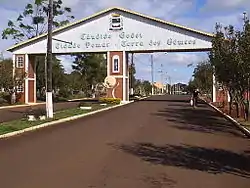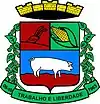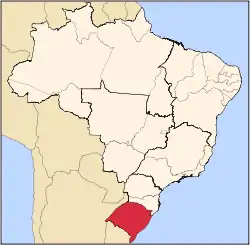Cândido Godói
Cândido Godói (Portuguese pronunciation: [ˈkɐ̃dʒidu gɔˈdɔj]) is a municipality of 6,151 inhabitants in the state of Rio Grande do Sul, Brazil near the Argentine border, famous for the high number of twins born there. The twin phenomenon is centered in Linha São Pedro, a small settlement in the city of Cândido Godói, in an ethnically homogeneous population of German descent.[4]
Cândido Godói | |
|---|---|
Municipality | |
 | |
 Flag  Seal | |
| Nickname(s): Terra dos Gêmeos (Land of Twins) | |
| Motto(s): Trabalho e Liberdade (Work and Freedom) | |
 Location in Rio Grande do Sul, Brazil | |
| Coordinates: 27°57′S 54°46′W | |
| Country | Brazil |
| Region | South |
| State | Rio Grande do Sul |
| Founded | September 10, 1963 |
| Government | |
| • Mayor | Valdi Luis Goldschmidt (PMDB) |
| Area | |
| • Total | 246.275 km2 (95.087 sq mi) |
| Elevation | 322 m (1,056 ft) |
| Population (2020 [2]) | |
| • Total | 6,151 |
| • Estimate (2008) | 6,762 |
| • Density | 26.5/km2 (69/sq mi) |
| Time zone | UTC-3 (UTC-3) |
| • Summer (DST) | UTC-2 (UTC-2) |
| [3] | |
Twinning rate
The rate of twin births in Cândido Godói is 10%, significantly higher than the overall 1.8% rate for the state of Rio Grande do Sul.[4] This rate is unusual, exceeding the highest observed national twinning rate (4.5 to 5% for southwestern Nigeria[5]). Nearly half (8 of 17) of twins examined in one study were monozygotic (identical) twins, a few more than the average of 30%.[4] Twin births were noted from the early twentieth century, when the first immigrants included seventeen sets of twins, and have been observed through several generations in the latter part of the twentieth century.[6]
The population is largely of Polish or German ancestry, with many tracing ancestry to the Hunsrück region of Germany, which has a higher than average twinning rate.[6] The rate in Cândido Godói could reflect genetic founder effect: rare genetic traits occurring by chance among a small group founding a community will be more common among their descendants than in the population at large.[7]
Explanation attempts
The notorious Nazi doctor Josef Mengele, who had conducted twin "studies" in Germany and experiments with twins in Auschwitz, is known to have fled to South America as the Allies were closing in on the Nazi German regime. The Argentine historian Jorge Camarasa has suggested that Mengele conducted experiments on women in the area, which could be responsible for the high ratio of twins.[8] According to some commentators, about the time of Mengele's arrival in southern Brazil in 1963, the incidence of twins began to increase, allegedly leading to the current rate of twinning at 1 in 10, over half of whom are dizygotic (fraternal).[4][9] However, such speculation has been disputed by local historian, Paulo Sauthier, who says Mengele did not study twins during his time in Brazil. Moreover, according to geneticists, the most likely explanation for the high frequency of twins is genetic isolation and inbreeding.[4][9][10] Records indicate that the high frequency of twins predates Mengele's arrival to South America.[11]
This phenomenon of a large number of twin births is not unique to Cândido Godói, and has also been observed in the town of Igbo-Ora in Nigeria and the village of Kodinhi in India.
See also
- List of municipalities in Rio Grande do Sul
- Riograndenser Hunsrückisch, the German dialect spoken locally; also the most widely spoken throughout the state
References
- Maps, Weather, and Airports for Candido Godoi, Brazil
- IBGE 2020
- IBGE Cidades (search for Cândido Godói)
- Matte, U; Le Roux, M. G.; Bénichou, B; Moisan, J. P.; Giugliani, R (1996). "Study on possible increase in twinning rate at a small village in south Brazil". Acta Geneticae Medicae et Gemellologiae. 45 (4): 431–7. doi:10.1017/S0001566000000829. PMID 9181177.
- "The Land of Twins: Seeing Double In Igbo-Ora". BBC World Service. 7 June 2001.
- "Nazi Mystery:Twins from Brazil". National Geographic Explorer. Archived from the original on 2010-05-20. Retrieved 2009-11-30.
- De Oliveira, M. Z.; Schüler-Faccini, L; Demarchi, D. A.; Alfaro, E. L.; Dipierri, J. E.; Veronez, M. R.; Colling Cassel, M; Tagliani-Ribeiro, A; Silveira Matte, U; Ramallo, V (2013). "So close, so far away: Analysis of surnames in a town of twins (Cândido Godói, Brazil)". Annals of Human Genetics. 77 (2): 125–36. doi:10.1111/ahg.12001. PMID 23369099.
- Evans, Nick (21 January 2009). "Nazi Angel of death Josef Mengel created twin town in Brazil". The Telegraph.
- Barrionuevo, Alexei (23 February 2009). "Mystery of the 'Land of Twins': Something in the Water? Mengele?". New York Times.
- Barrionuevo, Alexei; Domit, Myrna (24 March 2011). "In a Brazilian Town, a Rogue Gene and a Boom in Twins". The New York Times.
- Handwerk, Brian (25 November 2009). ""Nazi Twins" a Myth: Mengele Not Behind Brazil Boom?". National Geographic.
